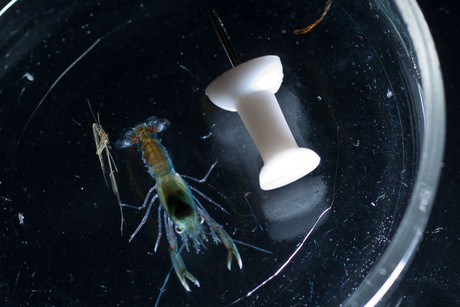The Wrack
The Wrack is the Wells Reserve blog, our collective logbook on the web.
The Wrack is the Wells Reserve blog, our collective logbook on the web.
I am on board the EPA Ocean Survey Vessel BOLD, with the opportunity to do ichthyoplankton (larval fish) monitoring at sea to supplement the nearly weekly ichthyoplankton tows my fellow intern Amanda has been doing this summer at Wells Harbor. We are interested in comparing the types of larval fish that are present a little way out to sea with those present in the harbor. Darcie Ritch, another summer intern who is working on her master’s degree at Antioch New England, is hoping to use the larval fish data I’m helping to collect on this trip in her masters project. Here is one of the first creatures we caught, a tiny lobster.

The EPA’s OSV BOLD is dedicated to environmental research at sea. This specific trip goes from Boston to Casco Bay and back, and is focused on collecting water samples to help establish nutrient limits (the maximum quantities of nitrates and phosphates in the water that will still allow healthy animal and plant life and clean water for fishing, kayaking, and other uses) for coastal waters.
To learn more about the OSV BOLD, and to see more photos and some videos of research at sea, check out http://epa.gov/boldkids/!
In the Salem Sound, we tried using the bongo nets available on board. Bongo nets allow collection of a duplicate sample, and the holders look like the frames for a huge pair of bongo drums. On the first try, the nets simply floated near the surface of the water. We attached a tongue-shaped metal depressor to try to get the nets to sink, and they did a graceful dive before rising up just below the surface again. Since our goal is to collect an integrated sample from three depths — below the area of the maximum concentration of chlorophyll, at the maximum concentration of chlorophyll, and just below the surface — we were trying to get the net to sink lower.
On Saturday, our second day at sea, things went much more smoothly. My shift for helping with the CTD (water quality sample collection device) was from 10 to 3. Around 2:30 or so, we started working on deploying the single plankton net I brought along from Wells. The ship’s crew and the EPA scientists have been incredibly helpful and supportive.
Attached to a boom which can pivot from a vertical support on the port side of the ship, the net can be lowered from a pulley. Nate, one of the survey technicians, wrapped electrical tape around the line at 10’ intervals so we could find out how many feet of line had been let out below the surface. For the first of today’s two tows, both at Plum Island Sound, at 2 miles out and 3 miles out, respectively, we attached the metal depressor only. The net sank but then drifted up a bit to what Matt Liebman, EPA chief scientist, and Nate estimated was about 5 feet below the surface. On the next tow, we also attached a weight with the depressor, and successfully towed at 100’ of line out, 50’ of line out, and, again, about 5’ below the surface.
The two sets of samples couldn’t look more different. Those from Salem Sound are chock-full of seaweed. Cory French, from the University of New England, found two larval pipefish in this sample. He and Tyler Spillane, also from UNE, picked out a whole school of juvenile herring. They were visible to the naked eye and looked like they were old enough to swim on their own (no longer larval fish). Also present were some tiny, tiny lobsters (pictured above) and countless larval crabs. The samples from Plum Island Sound had little to no seaweed or debris, yet still housed some tiny fish and other zooplankton. From now on, we'll be sticking with the single-net method, with a tow that starts deep and gets shallower in two steps. Tune in later this week to find out how it's going, and don't forget to take a look at http://epa.gov/boldkids. The site also includes Twitter updates detailing the latest happenings on board the BOLD.